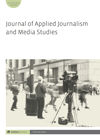
Full text loading...

 , Yaron Ariel1
, Yaron Ariel1
This study examined Israeli news professionals’ adoption and usage of Twitter as a journalistic tool. A mixed-methods approach was used, including a survey and open-ended questions, to gather data from 63 news staff members, including senior news presenters, correspondents and commentators. The results showed that Israeli news staff primarily use Twitter in a professional context and view it as a positive and essential work tool. Most respondents believed Twitter played a significant role in determining the media’s agenda and influencing the atmosphere among news staff. A one-way analysis of variance found that Twitter usage time was related to the perceived importance of the platform as a work tool and its influence on the journalistic field. The study also identified several reasons for adopting Twitter: curiosity, internal encouragement and pressure, access to quick updates and a wider range of sources, the opportunity to present a unique voice and the desire to reach new audiences.

Article metrics loading...

Full text loading...
References


Data & Media loading...
Publication Date:
https://doi.org/10.1386/ajms_00122_1 Published content will be available immediately after check-out or when it is released in case of a pre-order. Please make sure to be logged in to see all available purchase options.